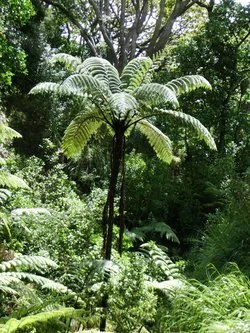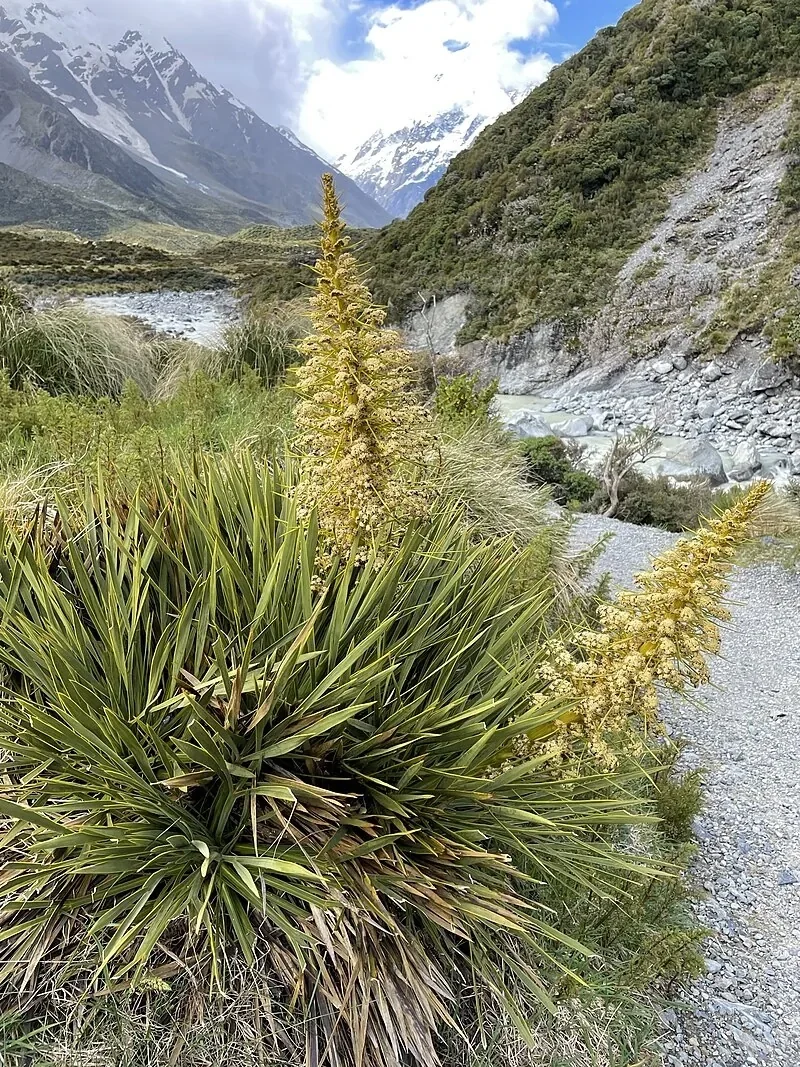
Mamaku
Sphaeropteris medullaris
Sphaeropteris medullaris , commonly known as mamaku or black tree fern, is New Zealand's largest and most spectacular tree fern , capable of reaching heights of up to 20 meters with a trunk diameter of up to 20cm. This magnificent species is native to the southwest Pacific, including New Zealand, Fiji, and Pitcairn Island. The distinctive black trunk is covered with hexagonal scars from old frond bases, giving it its common name. Known for its rapid growth of up to 50cm per year, mamaku produces massive fronds that can reach 5-6 meters in length, arching gracefully upward from the crown. The fronds are 3-pinnate and leathery, with the undersides bearing distinctive scales with marginal spines, making this an unmistakable giant of New Zealand's native forests.

Plant Description
Sphaeropteris medullaris (syn. Cyathea medullaris ), the mamaku or black tree fern, is New ZealandÃÃÃâÃâÃâÃÃÃâââ¬Ãà áÃâÃìÃÃÃâââ¬Ãà þÃâÃâs tallest tree fern, often 10-20 m with a massive, black trunk marked by distinctive hexagonal scar patterns. The arching fronds can exceed 5 m, forming an elegant shuttlecock crown; new croziers are glossy black with sparse scales.
Quick Facts
| Common Names | Mamaku, Black Tree Fern |
|---|---|
| Scientific Name | Sphaeropteris Medullaris |
| Family | Cyatheaceae (Tree fern family) |
| Growth Form | Large tree fern with single trunk |
| Height | Up to 20 m (tallest New Zealand tree fern) |
| Spread | 5-8 m crown spread with massive fronds |
| Water Needs | High - requires consistent moisture and humidity |
| Light | Partial shade to full sun (with adequate moisture) |
| Frost Tolerance | Hardy to -3°C once established, protect young plants |
| Salt Tolerance | Low - requires shelter from coastal winds |
| Growth Rate | Fast - up to 50cm per year in ideal conditions |
| Lifespan | Very long-lived (100+ years) |
| Trunk Diameter | Up to 20cm at breast height |
| Fronds | 5-6 m long, 3-pinnate, leathery with scaled undersides |
| Distinctive Features | Black trunk with hexagonal scars, largest NZ tree fern |
| Conservation Status | Not Threatened |
| Distribution | North Island, South Island, Stewart Island, Chatham Islands |
| Habitat | Lowland to montane forests, valleys, stream margins |
| Elevation Range | Sea level to 600 m |
Climate Best Suited to
Suited to mild, frost-free to light-frost climates with year-round moisture. Performs best in coastal to lowland districts with high rainfall or irrigation and shelter from hot, desiccating winds. Young plants are frost-tender; established trunks withstand brief light frosts if crowns remain hydrated.
Regional Suitability
| City | Climate Suitability |
|---|---|
| Whangārei | Ideal |
| Auckland | Ideal |
| Hamilton | Ideal |
| Tauranga | Ideal |
| Rotorua | Ideal |
| Gisborne | Ideal |
| New Plymouth | Ideal |
| Napier | Ideal |
| Whanganui | Ideal |
| Palmerston North | Ideal |
| Wellington | Ideal |
| Nelson | Ideal |
| Christchurch | Ideal |
| Dunedin | Ideal |
| Invercargill | Ideal |
Natural Habitat
Common in coastal to montane forests, stream gullies and regenerating scrub throughout much of Te Ika-a-Māui (North Island) and northern/western Te Waipounamu. Typically on moist, acidic, well-drained soils with constant humidity and filtered light.
Plant Conservation
Sphaeropteris medullaris , also known as mamaku or black tree fern, is a common plant found in lowland forests throughout the North Island of New Zealand and primarily in wetter coastal areas of the South Island. It is also distributed across the south-west Pacific from Fiji to Pitcairn Island. While specific IUCN conservation status is not explicitly stated, the species is described as "common" in its native range.
How to Grow
Planting Guide
Best Planting Practices
Plant in a wide hole enriched with leaf mould and compost; set rootball level, then water deeply through the crown-watering to prevent apical bud desiccation.
Ecology
Provides humid microhabitat for epiphytes, perching lilies and mosses; decomposing fronds feed the forest floor. Trunk skirts offer shelter to invertebrates and ground-foraging birds.
Uses
Mamaku serves as an iconic architectural specimen, perfect for creating dramatic focal points in subtropical and ngahere-style (forest-like) plantings. Its imposing stature and graceful fronds make it highly effective beside water features, in courtyard shade gardens, and as a natural canopy providing ideal conditions for delicate filmy ferns and other shade-loving plants.
Landscaping Ideas
Mamaku provides a dramatic vertical element in forest-themed gardens. Underplant its expansive canopy with delicate ferns like Hymenophyllum and Blechnum (Austroblechnum), and shrubs like Rhabdothamnus. Its distinctive black trunk offers a striking contrast to silver-foliaged astelias or glossy-leaved Pseudopanax, creating a visually rich and diverse native landscape.
Seasonal Care
Spring
Resume watering and feeding as croziers unfurl.
Summer
Maintain even moisture; mist crowns in heatwaves.
Autumn
Mulch heavily; reduce feeding.
Winter
Frost protection for juveniles; water the crown during dry spells.
Pruning
Pruning Techniques
Remove spent fronds cleanly at the trunk to keep the crown tidy. Do not damage the growing tip in the centre of the crown.
How to Grow Mamaku
Mamaku grows best when you match its natural habitat: prepare well-drained soil, get the light right, water steadily, and protect from extremes during establishment. This magnificent tree fern requires consistent humidity and protection from drying winds to thrive in cultivation, making site selection critically important for long-term success.
Spores
Mamaku reproduces naturally through spores produced on the undersides of mature fronds. Collect spores when they appear as brown, dusty patches on the fertile pinnae, typically during summer months. Sow spores immediately onto a sterile, peat-based growing medium and maintain high humidity in a closed propagation case. Keep consistently moist but not waterlogged, providing bright, indirect light at temperatures around 20-22°C. Spore germination is slow and requires patience, with prothallus development taking several months before recognizable fern plants emerge. Young sporophytes require extremely careful handling and gradual acclimatization to reduced humidity levels before transplanting.
Crown Division
Mature mamaku occasionally produce offsets from the base that can be carefully separated for propagation. Wait until offsets develop their own root systems before attempting division, typically when they reach 30-50cm in height. Use sharp, sterile tools to cleanly separate divisions, ensuring each section has adequate roots and growing points. Plant immediately into well-draining, humus-rich soil and maintain high humidity during establishment. This method provides faster results than spore propagation but suitable offsets are relatively rare.
Establishment Care
Young mamaku require extensive care during their first few years in cultivation. Dig wide planting holes in sheltered, humid locations and incorporate generous amounts of organic matter. Set plants at the same depth as they were growing previously and water thoroughly through the crown to prevent desiccation of the growing tip. Maintain consistent moisture and high humidity by mulching heavily and providing wind protection. Feed regularly with liquid fertilizer during the growing season and protect from frost until trunks develop sufficiently. Refresh organic mulch annually to maintain soil health and moisture retention for long-term performance.
Pests and Diseases
Common Problems and Solutions
Snails and slugs can scar croziers; scale insects may colonise trunks in dry, shaded sites-treat with horticultural oil. Frond scorch results from low humidity or hot winds.
Cultural Significance
Traditional Uses and Values
Sphaeropteris medullaris The plant, commonly known as mamaku or black tree fern, holds significant cultural importance, particularly within Māori culture in New Zealand, and also has historical uses among Indigenous Australians. In traditional Māori culture, the drooping fronds are associated with grief and sorrow. A traditional Māori story recounts Mamaku and Toroa (the albatross) as human lovers whose constant arguing angered the gods, leading to their transformation into the tree fern and albatross, respectively. The pith from the trunk and the coiled young fronds were a traditional food source, often considered a "famine food" but also served as a "special relish at feasts." The mucilage from the sap and the pith were applied as poultices for skin conditions and to alleviate fatigued limbs. Sap from new frond stipes was used for sunburn, boils, and as a coagulant to stop bleeding. The bark of the mamaku is also used to create a traditional Māori musical instrument called a rōria (a taonga pūoro). Among Indigenous Australians, historical records indicate that the pith of the fern tree was consumed, as it contained starch similar to sago.
Bonus Tip
Expert Growing Advice
In containers or dry climates, occasionally pour a bucket of water through the crown to hydrate the pith and prevent bud loss.







